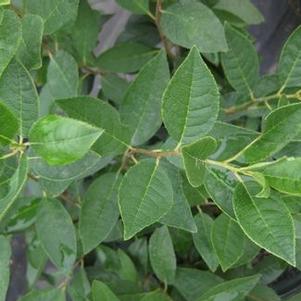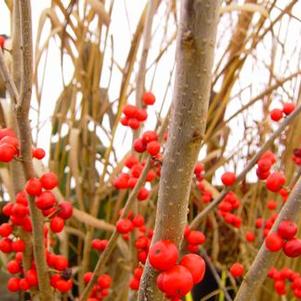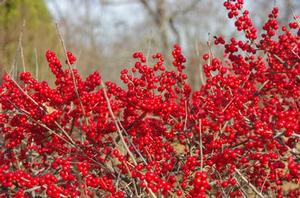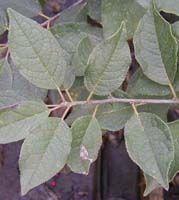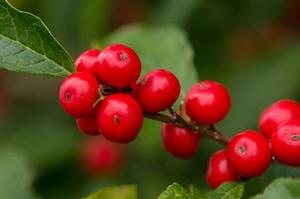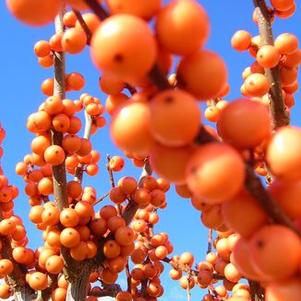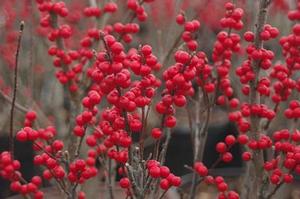Very Berry Verticillata
If you know us at all, you were probably expecting a showcase on Ilex verticillata, winterberry holly, at some point this season. Well, here it is! Without fail, our winterberry hollies are in full fruit around the Nursery – our stock crops are still a little young, and thus light on fruit, but we’ll get into that shortly. In the meantime, let’s check out some little-known Ilex verticillata facts along with pictures of some specimens that have either been intentionally planted, or volunteered themselves, around the Pleasant Run property.
There is no shortage of literature available on winterberry hollies. One quick Google search unleashes a tsunami of information on the native shrub, leading one to think, “What more could possibly be said about a plant that everyone already knows and loves?” Challenge accepted.
Let’s get the basics out of the way: Ilex verticillata is a deciduous member of the holly family, Aquifoliaceae, and like other hollies it requires both female and male counterparts in order to ensure successful pollination and subsequent fruit set. Winterberry hollies can be found happily growing in boggy conditions, along streambanks, bioswales, and pond edges, as seen in several pictures of specimens found growing along the Run (ya know, the body of water that we borrow our name from). Winterberry holly is also referred to as black alder due to the color of the foliage following the first frost, which takes on a brownish-black tone before shedding. The small flowers, which appear between June and July, later in the season than those of Ilex opaca, are a generalist pollinator’s dream: wasps, bees, flies, and various butterflies are known to collect winterberry nectar, including our native Henry’s Elfin butterfly, which uses the shrub as a larval host. After the flurry of pollinators have completed their nectar collection over the course of the summer, properly-pollinated ovaries develop into brightly colored, overt berries that whorl tightly around branches. It is this placement of the berries that gives this holly its specific epithet: verticillata roughly translates to mean “a whorled pattern”. The berries persist on the plant long after the foliage has abscised, often into March of the following year, providing a much-needed splash of color in the dreary winter landscape.
Despite being touted as an indisputable favorite food of birds, it is actually the straight species Ilex verticillata that gets the most attention from our feathered friends. While they will and do visit the cultivars, it’s been noted that the ornamental selections tend to retain their fruit for longer into the season, while birds tend to seek out and forage from non-cultivar selections first. Alternatively, birds have a tendency to glean the berries from Ilex opaca prior to those of Ilex verticillata, and that’s not just because they’re considerate of your wintertime aesthetic needs. Despite being less visually attractive to birds, and lower in carbohydrates, it turns out the berries of our native American holly maintain a consistent level of saponins throughout their development, while winterberry holly fruits experience a saponin-spurt approximately mid-way through their developmental period. For those of you that aren’t keeping up with your phytochemical terminology, saponins are the compound that give plant materials a “soapy” taste, and are also derived from said plant materials for the production of cleaning products such as detergent. No wonder birds prefer lower saponin levels – you wouldn’t want to be eating a mouthful of soap, either! Once the fruits transform from their young, green state to their mature, red, orange, or yellow state, their saponin levels decrease, making them slightly more palatable for hungry critters. Similar to persimmon fruits, winterberry holly fruits increase in sugar content after experiencing several hard freezes, making them more delectable to birds. Saponins or not, winterberry holly fruits are a favorite snack of many: winter-visiting catbirds and mockingbirds, brown thrashers and hermit thrushes have a particular soft spot for the berries, while other birds such as red-winged blackbirds can be found using the shrub for shelter and as a nesting site. Up to 40 different animal species (songbirds, waterfowl, and mammals alike) are known to eat the native berries. Robins and cedar waxwings are some other frequent visitors of Ilex verticillata, the latter consistently preferring red berries and seeking them out from all sources, gorging themselves until nearly drunk on pulp and juice. Ilex verticillata provides all of the fruit cedar waxwings could hope for. Winterberries are not only an ecologically friendly native option for the aforementioned bird species, but maybe a lifesaving resource for cedar waxwings. These birds have a tendency to overeat no matter what they’re grazing upon. This has made plants such as Nandina domestica, with its toxic berries, problematic for berry-bingers like the cedar waxwing. They’ll continue to eat until they physically cannot consume any more, and thus the cyanide naturally produced by Nandina fruits can prove fatal to an insatiable cedar waxwing. Instead, try incorporating bird-friendly natives that provide just as much (if not more) ornamental value to the landscape. Ilex verticillata is a pretty good place to start. And, because cedar waxwings tend not to be picky, they definitely won’t discriminate about whether or not you have a ‘Winter Red’ or a ‘Red Sprite’!
Before you go willy-nilly slapping winterberries into the landscape, keep in mind that each lady has a very specific male partner, complete with a coinciding bloom time for adequate pollination. These boys are pretty popular, too: ‘Southern Gentleman’ and ‘Jim Dandy’ each have a harem of female winterberries. Of our winterberry collection here, ‘Southern Gentleman’ is betrothed to ‘Winter Red’ and ‘Winter Gold’, while ‘Jim Dandy’ is the patriarch of Wildfire™, ‘Red Sprite’, and ‘Maryland Beauty’. Each male shrub is capable of pollinizing anywhere between 6-10 female shrubs, so long as they are located within 50 feet of the ladies. Best flower and fruit production occurs on old wood, meaning they don’t require much pruning or overall maintenance for a fantastic display of flowers and fruit. Typically, the best winterberry holly fruit production occurs between two and three years after the plant has been established in its site. Ours here on the farm are on the younger side, with light fruit sets, but that’s not to say that they won’t be absolutely covered in a couple of years after they’ve been transplanted into their forever home.
Check out our quantities and corresponding write up for each of our wonderful winterberry varieties, available now and ready to make a statement in the landscape!
Male: ‘Jim Dandy’
Female Partners:
‘Red Sprite’
‘Maryland Beauty’
Wildfire™
Male: ‘Southern Gentleman’
Female Partners:
‘Winter Red’
‘Winter Gold’
Barlow, V. (2006, December 1). Winterberry, Ilex verticillata: Winter 2006: Articles. Northern Woodlands. https://northernwoodlands.org/articles/article/winterberry_ilex_verticillata
Bricault, B. (2021, March 9). Winterberry: Michigan’s native Holly. MSU Extension. https://www.canr.msu.edu/news/winterberry_michigans_native_holly
Dengler, H. W. (1957). Ilex verticillata (L.) Gray. In Handbook of Hollies (1st ed., Vol. 36, pp. 18–19). essay, American Horticultural Society.
Friends of the Rouge. (n.d.). Flora Feature – A Wintertime Bounty For Birds - Friends of the Rouge. https://therouge.org/flora-feature-winterberry/
Galle, F. C. (1997). Deciduous Holly Species. In Hollies: The Genus Ilex (pp. 143–143). essay, Timber Press, in association with the Holly Society of America, Inc.
Gargiullo, M. B., & Stiles, E. W. (1993). Development of secondary metabolites in the fruit pulp of Ilex opaca and Ilex verticillata. Bulletin of the Torrey Botanical Club, 120(4), 423. https://doi.org/10.2307/2996746
Hinkley, D. J. (2008, October 27). Ilex verticillata - Horticulture. Horticulture. https://www.hortmag.com/plants/ilexverticillata
Hirvela, S. (n.d.). Ultimate Guide to Winterberry Holly. Proven Winners. https://www.provenwinners.com/learn/plant-growing-guide/ultimate-guide-winterberry-holly
NC State Extension. (n.d.). Ilex verticillata. Ilex verticillata (Black Alder, Common Winterberry, Winterberry, Winterberry Holly) | North Carolina Extension Gardener Plant Toolbox. https://plants.ces.ncsu.edu/plants/ilex-verticillata/
Oder, T. (2019, December 23). Why Nandina Berries and Certain Birds Don’t Mix. Treehugger. https://www.treehugger.com/nandina-berries-cedar-waxwing-4863712#:~:text=Nandina%20berries%20actually%20have%20a%20low%20toxicity%2C%20but,The%20Nature%20Conservancy%20and%20Cornell%20Lab%20of%20Ornithology.
Strauch, B. (1999, December 1). Herb to know: Winterberry - Mother Earth Living. Mother Earth Living - Healthy Life, Natural Beauty. https://www.motherearthliving.com/gardening/plant-profile/AN-HERB-TO-KNOW-43/
See all our Woody Ornamentals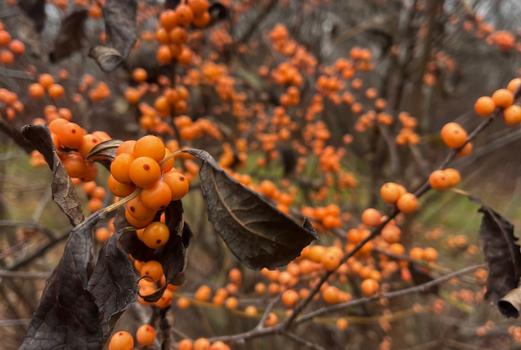
Ilex verticillata 'Winter Gold'


